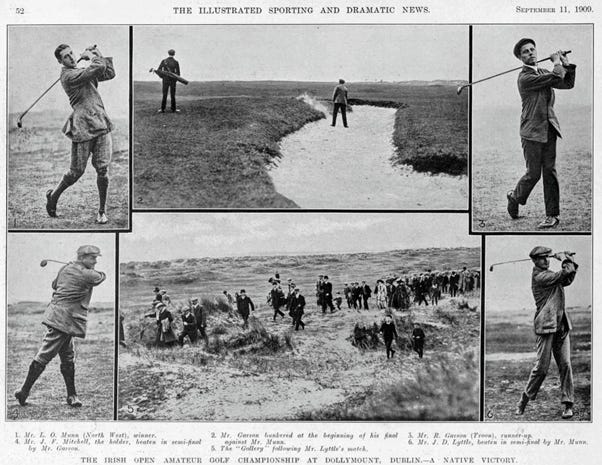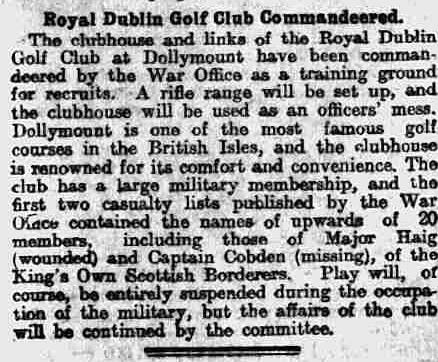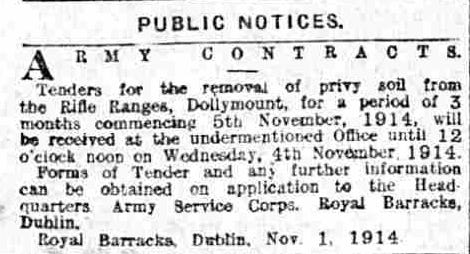September 2024 marked 110 years since the British Army’s requisitioning of Bull Island and the Royal Dublin Golf Club clubhouse and golf course. The Army transformed the vast majority of the island into the Irish Command School of Musketry and Machine Gunnery at Dollymount.
The Golf Club had moved to Dollymount in 1889, having spent the majority of the preceeding three and a half years at the Phoenix Park, and then fleetingly at Cush Point (current home to Sutton Golf Club ). In 1889 the club received permission from Colonel John Vernon and the Dublin Port & Docks Board to decamp to Bull Island.
Interestingly, as you will see below, 1914 was not the first, nor the last, time that Dollymount was considered for use as a rifle range.
The International Rifle Match June 1875

The match was held on the June 29th 1875 on Dollymount . For the previous two days it had rained heavily and the city was sodden with water but the day of the match saw an end to the rain although overcast skies and a yellow fog came down on the city that morning.
The American International Shooting team had arrived several days before the 29th and went straight into a closed practice regime which they followed without regard to the heaviness of the rain or the strength of the wind. They continued this regime each day, politely refusing invitations to the various “garden parties”, “flower shows” and “trips in the bay”, until the day came when they at last felt sure of their rifles and the conditions of the Dollymount range. On this day they held an open practice session for the members of the press and produced a tremendous score. All the hard work and discipline of the Americans was paying off and they felt ready for the main event.
Meanwhile, when the Irish team, who were busy entertaining the remainder of the American entourage, caught wind of their competitors score, they became slightly worried and decided to put in a little practice of their own which consisted of shooting five shots at each distance. The result was not what they had expected nor hoped for and the mood in the Irish camp began to grow ominous.
When the morning of the 29th finally arrived, thousands of spectators began flocking to the strand from all over the city and its surrounds. Dublin had never seen such a spectacle before.
The match itself would follow the same course of fire as did the match held the previous year at Creedmoor. Each man would take 15 shots at 800, 900 and 1000 yards. With 800 yards to begin and the markers at their places in the butts, the red danger flag was lowered and the bugle sounded the start of the Great Dollymount Rifle Match of 1875.
The American team won the match, holding onto the well earned win that had been secured in the previous years match.
1890 – War Office inspects North Bull Island – Irish Times Report – October 20th, 1890.
We are authorised to state that no final arrangements have been made with regard to having a military rifle range of Dollymount An official from the War Office inspected the site in order to report its suitability, but no negotiations have been entered into with the owners of the property, nor is there much likelihood that any proposals of the military authorities on that head will be favourably received.
The Outbreak of WW1 – Belfast Newsletter 8th September 1914
Army Contract for Soil Removal – tender request advertisement
Evening Herald – November 2nd 1914
Tenders for the removal of privy soil from the Rifle Ranges, Dollymount for a period of 3 months commencing 5th November 1914, will be received at the under mentioned office until 12:00 noon on Wednesday 4th November 1914.
Forms of tender and any further information can be obtained on application to the Headquarters Army Service Corps, Royal Barracks, Dublin.
Royal Barracks, Dublin, November 1st, 1914.
Excerpt from December 1914 sub-letting agreement with the War Office
The term of this agreement shall be 6 calendar months from the 7th day of September 1914 and thereafter for so long as the exigence of the public service shall require and may be determined by the Secretary of State at the end of the set six months are thereafter at any time by one calendar months’ notice in writing, transmitted by post to the last known address in the United Kingdom of the Secretary of the Royal Dublin Golf Club. The Secretary of State shall on the exploration or determination of this agreement restore the said lands and clubhouse and the fixtures and equipment thereof so far as possible to the original condition on the 7th September 1914 or pay compensation in lieu of such restoration.
The extent of the WW1 Rifle Ranges
Recent searches have uncovered a British War Office scale map, shown below. It illustrates the, perhaps surprising, extent of the portion of the island that was used to accommodate the Irish Command School of Musketry and Machine Gunnery at Dollymount.
Significant additional information pertaining to the Dollymount’s use as a rifle range during the Great War appears to be available at the British National Archives in Kew, it is hoped that this information will be uncovered over the next few months.
Letter to Cecil Barcroft (Secretary of Royal Dublin) from Commandant H.F. Sommerville – reported in the Irish Times 7/10/1916
We have remade seven of the old holes and made two new ones on the South side of the butts at Dollymount, and the course, although very rough at present, will I hope, be quite a good 9 hole course in time. Owing to shooting on the ranges, members can only play on Sundays all day, on Saturdays after 1:00 PM and every second and fourth Wednesday in the month, also from 1:00 PM.
We shall be very pleased if all members of the Royal Dublin Golf Club will consider themselves honorary members of the course and also of the mess on the above days. We are setting aside a room as a dressing room for the RDGC members and special passes admitting members to the camp at the above times will be issued on application to the adjutant. As you will understand, it may be necessary, owing to military reasons, to suspend play on certain days and in order to avoid disappointment it would be advisable for members to ring up the mess steward and ascertain if the links will be open for play on that day.
Weird Golf – Irish Independent 2/9/1954
Sir. Your recent article on the Royal Dublin Club omits reference to the period when it housed the Irish Command School of Musketry and Machine Gunnery. Many of us members of the 47th Irish Brigade, qualified there as instructors of musketry and in leisure hours played some weird golf. For lack of orthodox clubs, hurleys and hockey sticks were not disdained and I recollect one cavalryman playing a devastating game with that species of walking stick known as a ‘Penang Lawyer’.
Yours
FD Hickey.
Bank Place, Carndonagh.
The Cleanup & Aftermath of Dollymount’s Occupation – from the memoirs of Sir Anthony Brutus Babington
When the 1914 war broke out, Royal Dublin was handed over to the military, lock, stock and barrel on a verbal agreement that they would see us decently treated when the war was over. This promise was kept, and in 1919 we began the reconstruction, with the advice and help of Mr Harry Colt, then Secretary of Sunningdale, who was a friend of Barcroft’s and became a great friend of ours. The course then had a sixty four target range right across it and these had to be removed. I remember that we collected seven tons of .303 bullets on the second half of the course.
Mr. Colt always stayed with us when he was in Ireland and I was associated with him when he designed and supervised the construction of the Royal Belfast and Royal Portrush courses. I have written of my connection with the latter club from 1923 to the present time and an appreciation of Mr. Colt elsewhere. My memory of him is still as vivid, as his personality was captivating and notable in any company.
Post Script
Further recollections from the memoirs of Sir Anthony Brutus Babington
One day after the Irish Free State agreement had been signed, and the new government was being set up, I was out on the course when someone came running out to say that the Free State military had come to take it over and were in the clubhouse, to which I immediately betook myself. There I found four gentlemen all in uniform, three of them with revolvers stuck in their belts, and the spokesman informed me that they were taking the course over as a range. One was a Colonel, two were I believe Commandants and the fourth a nondescript.
My first question was whether they were teetotallers and on being reassured, we sat down to discuss their proposal. I had a word with Annie McDowell, who presided at the bar and told her to bring in a round of drinks – whiskey of course and double ones – and to repeat the dose when I gave her the signal. The Commandants were Americans – one called Durveen, the other Collins and we had a general conversation before we got down to brass tacks.
Durveen came from Chicago and I asked him where he started life and he said as a small boy he attended a public sports ground in Chicago and was spotted by a trainer as a likely runner. He was then taken up and became a national sprinter. When the war broke out, he joined the Canadian forces. He fought through the war finally in Russia and when the war was over, he looked round and saw that his native country was at war and came over to Ireland as a soldier of fortune to try his luck. He had parked his revolver on the table among the glasses and was quite frank and willing to talk, and this willingness increased as Annie McDowell did her job.
Collins’ background did not appear, but he said he had been blowing up lighthouses in Donegal. When we got onto the object of their visit, I told them the clubhouse was a national asset, that we had no political taint as a club and that their government would be getting over the range at Ticknock in a few days.
After a couple of hours argument they agreed that they would go back and advise their superiors that we should be left alone and we went into the Secretary’s room to draw up a memorandum to this effect. The little Irishman was directed to be the scrivener, and when our Secretary Bancroft produced a sheet with Royal Dublin Golf Club printed in red on it, he objected to use the word “Royal” and X said that this was abolished. I pointed out that it was not abolished and would remain the title of the club until some competent authority changed it. The Americans agreed and the memorandum was drawn in the name of the Royal Dublin Golf Club. I think I was captain at the time and Bancroft and I signed it.
This was on a Saturday and I often wondered what the many members sitting in the club thought when they saw us staggering down the outside staircase from the first floor, with two soldiers one on each side, with their arms round my neck, and none of us at all steady on our feet. But we got away with it and the memorandum was honoured and the club is still the Royal Dublin Golf Club. My bill for liquor was over five pounds, which was good enough at the 1923 price, and the six of us were pretty tight.
Keep an eye out for additional content pertaining to the Royal Dublin history project over the coming months – there may well be a podcast episode upcoming on some of the findings also.
Thanks for reading, until the next time, happy golfing!
Shane D









